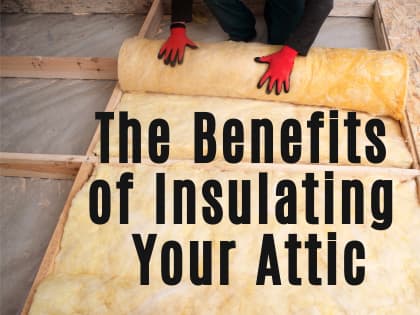The Benefits of Insulating your Attic
 Your attic does much more for your home than storing your stuff. It is designed to provide a protective barrier for your home from cold, heat and humidity. But in order for the top area of your home to do its job, you need your attic properly insulated.
Your attic does much more for your home than storing your stuff. It is designed to provide a protective barrier for your home from cold, heat and humidity. But in order for the top area of your home to do its job, you need your attic properly insulated.
According to the North American Insulation Manufacturers Association (NAIMA), 90 percent of single family homes in the US are under insulated. If your attic isn’t insulated or hasn’t been insulated for years, it could compromise your home’s safety, efficiency and comfort. What are the benefits of insulating your attic? Learn more below.
Lower utility bills
Heating and cooling account for 50 to 70 percent of the energy used in the average American home. And if your home is uninsulated or under-insulated, you’ll spend extra money trying to maintain comfortable temperatures. How much money can you save by insulating your attic? According to the Environmental Protection Agency, you can save an average of 15 percent on heating and cooling costs (or an average of 11 percent on total energy costs) by air sealing your home and insulating attics, floors and crawl spaces. How much money you will save may depend on a number of factors, including your family's lifestyle, your home’s design and your type of heating system, but you can expect big energy savings which translate to big dollar savings. In fact, the average homeowner can save about $780 per year.
Safer home structure
Insulating your attic can prevent gradual damage to your home, caused by heat and moisture. It prevents water vapor from seeping in and eroding your walls. It also slows down heat buildup in your attic, which can cause the shingles on your roof to swell and crack or cause the plywood on your deck to soften. It prevents ice dams from forming when melting snow refreezes on your roof’s edge. Furthermore, insulating your attic can prevent mold that thrives in moist, cool areas. Insulation stops these problems from occurring by mitigating the effects of condensation.
Better indoor air quality
Outdoor pollutants such as dust, dirt, mold, mildew and even worse can enter your home through air leaks caused by poor insulation. As time passes, the accumulation of these airborne toxins can seriously compromise your indoor air quality. Insulating your attic maintain prevents these pollutants from spreading throughout your home, allowing your family to breathe easier and enjoy a cleaner indoor environment. In addition, installing new insulation can remove pollutants that may have lived on your old insulation.
Better indoor comfort
Heat naturally flows from warmer to cooler places. And even homes that are equipped with modern heating and cooling systems can cause severe temperature fluctuations when under-insulated. This means that the home can become hot or cold more quickly when the temperature changes outside, and that rooms on upper floors may differ in temperature significantly from those on lower floors. A temperature difference of 10 to 15 degrees between floors in your home is a sure sign that your home has too little insulation. Most bedrooms in U.S. homes are located on upper floors, so adding insulation is a great way to ensure comfort at night and in the early morning, when temperatures are at their lowest.
Less HVAC wear and tear
Older homes tend to be drafty, and poor insulation can cause your heating and cooling systems to work overtime to maintain an even temperature. These temperature swings can become even more exaggerated in homes where ductwork runs through the attic. Proper attic insulation prevents cool air from lingering at the lower levels while heat rises, resulting in less and tear on your HVAC unit. With less heat gain in the summer and heat loss in the winter, you’ll reduce your family’s reliance on your home’s heating and cooling systems while maintaining comfortable indoor temperatures year-round.


